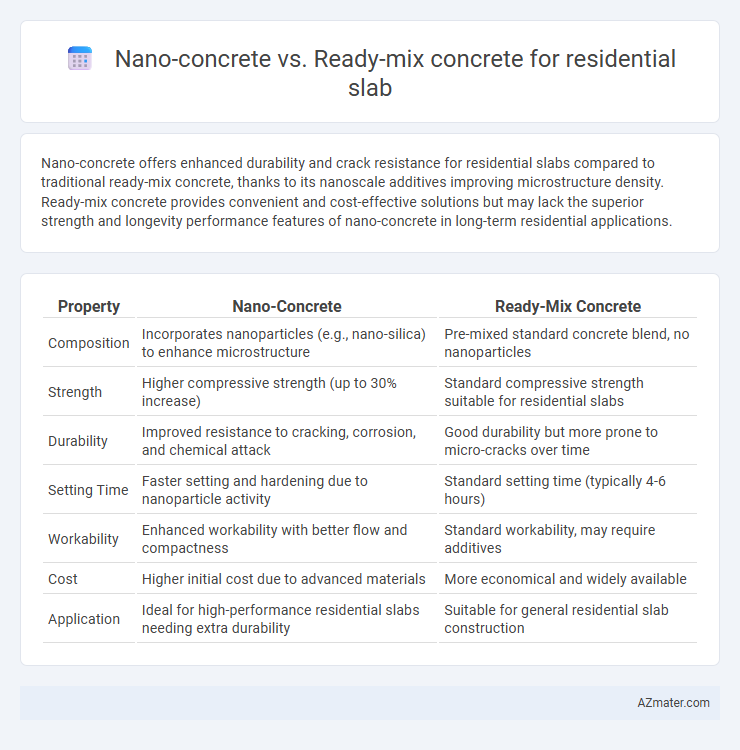Nano-concrete offers enhanced durability and crack resistance for residential slabs compared to traditional ready-mix concrete, thanks to its nanoscale additives improving microstructure density. Ready-mix concrete provides convenient and cost-effective solutions but may lack the superior strength and longevity performance features of nano-concrete in long-term residential applications.
Table of Comparison
| Property | Nano-Concrete | Ready-Mix Concrete |
|---|---|---|
| Composition | Incorporates nanoparticles (e.g., nano-silica) to enhance microstructure | Pre-mixed standard concrete blend, no nanoparticles |
| Strength | Higher compressive strength (up to 30% increase) | Standard compressive strength suitable for residential slabs |
| Durability | Improved resistance to cracking, corrosion, and chemical attack | Good durability but more prone to micro-cracks over time |
| Setting Time | Faster setting and hardening due to nanoparticle activity | Standard setting time (typically 4-6 hours) |
| Workability | Enhanced workability with better flow and compactness | Standard workability, may require additives |
| Cost | Higher initial cost due to advanced materials | More economical and widely available |
| Application | Ideal for high-performance residential slabs needing extra durability | Suitable for general residential slab construction |
Introduction to Nano-Concrete and Ready-Mix Concrete
Nano-concrete incorporates nanoparticles to enhance durability, strength, and crack resistance, making it suitable for high-performance residential slabs. Ready-mix concrete is pre-mixed in controlled plants and delivered directly to construction sites, offering consistent quality and efficient placement for residential foundations. Both materials serve distinct purposes with nano-concrete emphasizing advanced material science and ready-mix concrete focusing on construction convenience.
Composition and Material Differences
Nano-concrete incorporates nanoparticles such as nanosilica and nanoclay to enhance material density and strength, differing from ready-mix concrete which uses traditional cement, aggregates, and water without nano-additives. The nano-sized particles in nano-concrete improve hydration, reduce porosity, and increase durability, making it ideal for high-performance residential slabs. Ready-mix concrete relies on standardized mixtures tailored for general construction, lacking the improved mechanical and chemical properties found in nano-enhanced formulations.
Strength and Durability Comparison
Nano-concrete exhibits superior strength and durability compared to ready-mix concrete for residential slabs due to its enhanced microstructure and reduced porosity from nanomaterial additives. This results in higher compressive strength, improved resistance to cracking, and better long-term performance under environmental stress. Ready-mix concrete, while convenient, typically offers lower tensile strength and is more susceptible to shrinkage and durability issues over time.
Workability and Application Techniques
Nano-concrete exhibits superior workability due to its enhanced particle dispersion and reduced water-cement ratio, facilitating easier placement and compaction in residential slabs. Its application techniques require precision in mixing and curing to leverage nanoscale additives that improve strength and durability, often demanding specialized equipment or training. Ready-mix concrete offers consistent workability through controlled batching at plants, enabling quick and efficient pouring on-site but may require additives to match the advanced properties of nano-concrete.
Setting Time and Curing Requirements
Nano-concrete exhibits significantly faster setting times compared to traditional ready-mix concrete, often reducing initial set time by up to 30%, which accelerates construction schedules for residential slabs. Its enhanced curing requirements involve maintaining moisture levels for shorter durations, typically 3 to 5 days, versus the 7 to 14 days needed for ready-mix concrete to achieve optimal strength. This advanced material also improves early strength gain, enabling quicker load application and reducing project turnaround times.
Cost Analysis: Nano-Concrete vs Ready-Mix
Nano-concrete typically incurs higher initial costs due to advanced materials and technology integration, but provides enhanced durability and reduced maintenance expenses over time for residential slabs. Ready-mix concrete offers lower upfront costs and faster application, benefiting budget-sensitive projects with standard durability requirements. Evaluating total lifecycle cost reveals nano-concrete's potential for greater long-term savings despite its premium price compared to conventional ready-mix concrete.
Sustainability and Environmental Impact
Nano-concrete incorporates nanoparticles that enhance durability and reduce material usage, resulting in lower carbon emissions compared to traditional ready-mix concrete. Its improved hydration process and reduced permeability extend the lifespan of residential slabs, minimizing the need for frequent repairs and resource consumption. Ready-mix concrete, while convenient, typically has a higher environmental footprint due to standardized mixing and transportation emissions.
Performance in Residential Slab Construction
Nano-concrete exhibits superior performance in residential slab construction due to its enhanced mechanical properties, including higher compressive strength and improved durability compared to ready-mix concrete. Its nano-scale additives lead to reduced porosity and increased resistance to cracking, ensuring long-lasting structural integrity under residential load conditions. Ready-mix concrete offers convenience but may not match the long-term performance benefits of nano-concrete in minimizing maintenance and repair costs for residential slabs.
Maintenance and Lifespan Considerations
Nano-concrete offers enhanced durability and reduced micro-cracking compared to traditional ready-mix concrete, resulting in lower maintenance requirements for residential slabs. Its nanoscale additives improve resistance to environmental degradation, extending the slab's lifespan beyond conventional concrete by up to 30%. Ready-mix concrete, while more cost-effective initially, may require more frequent repairs and sealing to address wear and moisture penetration over time.
Choosing the Right Concrete for Residential Slabs
Nano-concrete offers enhanced strength, durability, and resistance to cracking compared to ready-mix concrete, making it ideal for high-performance residential slabs. Ready-mix concrete provides convenience, consistent quality, and quicker installation, which suits standard residential projects with typical load requirements. Selecting the right concrete depends on project budget, structural demands, and long-term longevity considerations for the residential slab.

Infographic: Nano-concrete vs Ready-mix concrete for Residential slab
 azmater.com
azmater.com